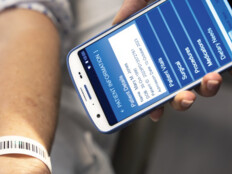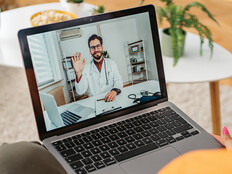How Mobile Tools Help Healthcare Providers Optimize Care, Improve Collaboration
A majority of healthcare leaders — 85 percent — say that digital innovation is tied to their long-term strategies to improve care, according to the American Hospital Association and AVIA.
It makes sense, then, to provide them with devices they can use easily, anytime and anywhere. To that end, organizations today deploy a variety of solutions to help clinicians deliver more timely, precise care and improve communications and collaboration between colleagues.
For instance, some facilities provide tablets, smartphones or specially designed mobile computers to doctors, nurses, physician assistants, technicians and other clinicians, enabling them to retrieve and record information more efficiently. Others have launched BYOD programs so staff can use their personal devices for work. Armed with such tools, a clinician can access a patient’s electronic health record (EHR) during an exam, submit a discharge order or call in a prescription on demand.
Mobile Devices Offer Clinicians Timely Results
An emphasis on mobile tools and initiatives has transformed healthcare processes. Previously, technicians would fax lab information to a centralized location on a hospital floor, where it would sit until a nurse or administrator received it. Now, nurses equipped with smartphones that feature secure messaging can receive lab information as soon as it’s available. If urgent action is required, a sender can even set priorities for delivery, as well as an escalation path in the event the nurse does not respond within a set period of time.
Mobile devices also make it easier to share timely data across multiple groups. Referring again to lab reports as an example: Upon receiving a report via fax, a nurse would need to notify the on-call doctor; if the doctor is unavailable, a voicemail would be left. Hours might pass before the doctor receives the voicemail and ultimately authorizes a reduction or increase in medication based on the lab results. Such a delay could put patients at risk.
With a collaboration solution in place, all involved parties can be informed simultaneously, reducing the overall time to care.
That timeliness of data is essential to healthcare professionals. Instead of phone calls and voicemail, clinicians can use secure messaging and other real-time technologies to streamline communications between necessary parties involved in patient care. Hospitals could also implement a Voice over IP (VoIP) solution for clinical communication.
These technologies all translate into better care outcomes and a subsequent return on investment for the hospital as clinicians can process patient discharge orders more efficiently and turn around rooms more quickly, reducing the average length of stay.
All-in-One Solutions Streamline Care
Device consolidation represents another benefit of healthcare mobility. Because clinicians spend so much time on their feet, enabling them to do their jobs with fewer devices simplifies their workload and improves efficiency.
In addition to secure messaging, doctors, nurses, technicians and staff can use smartphones, tablets and other similar tools for a variety of purposes. When a patient hits the nurse call button, for instance, instead of an alert going to a fixed nursing station, it can go directly to the on-call nurse’s smartphone or mobile computer, allowing for a timelier response. Hospitals can also integrate alerts and alarms into smartphones that tie back to patient monitoring systems.
What’s more, many hospitals use such devices for barcode medication administration. Instead of deploying workstations-on-wheels equipped with several separate scanners, each with a specific purpose, clinicians can use smartphones or mobile computers to scan barcodes for various use cases. For instance, nurses can scan both patient and medication barcodes to ensure the right drug and dosage are being administered. That frees up time and reduces potential errors.
Mobility is also proving valuable outside the walls of the hospital. A home health nurse with a smartphone, for instance, can communicate with colleagues and access information more effectively and efficiently while in the field. And specialists can examine patients remotely using mobile tools and telemedicine software, which expands their reach. In fact, three-fourths of senior healthcare executive respondents to a survey conducted by Foley & Lardner say they either offer or plan to offer telemedicine services to patients. More than 80 percent say telemedicine is also spurring expansion of overall digital health services.
The Growth of IoT Leads to a Patient Data Boom
Additionally, wearable devices are helping provider organizations streamline and improve clinical care. Tools such as smartwatches allow physicians to track their patients’ blood pressure, heart rate, sleep patterns and other vitals between visits, providing them with a more complete picture of their health. Insights gleaned from wearables can also be valuable in preventing recently released hospital patients from being readmitted.
With the growth of the Internet of Things in healthcare, data gathered from patients is poised to explode in the near future. Analysts estimate that one-quarter of all clinical data is already being provided directly by patients.
There are a variety of use cases for mobile devices in healthcare, and many organizations begin with a tiered rollout. Providers, for instance, may start with secure messaging on smartphones, and then add other use cases, devices and back-end infrastructure in stages. That provides IT staff and administration time to customize solutions to their needs, while also giving clinical staff an opportunity to learn how to use new tools and implement them into their workflow.
Healthcare providers now more than ever deploy mobile technology to enable timely patient care and boost collaboration. Learn more by downloading the white paper "Mobile Technology Enhances Next-Generation Care Delivery."








